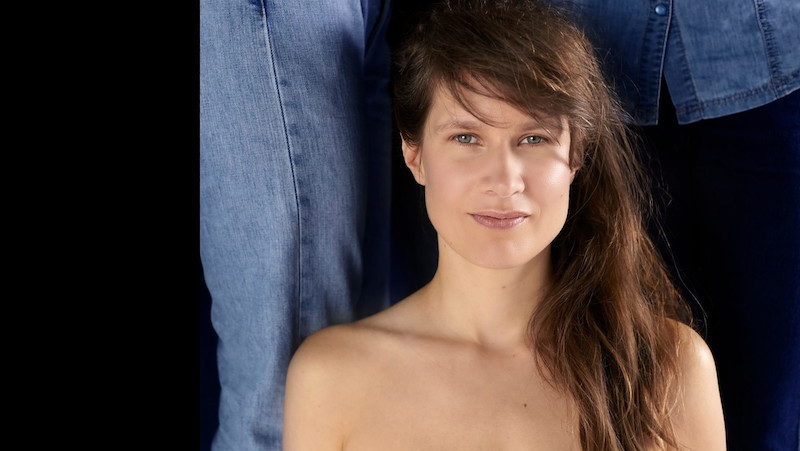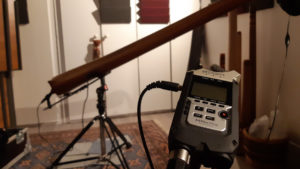It never fails.
At every workshop, I get this question: “By the way Gauthier, do you know why so few women play the didgeridoo?!”
So I suggest we take a closer look at this situation that raises so many questions!
A majority of men on Wakademy
First of all, I’ll share the numbers I have. Whether it’s Wakademy members, students who attend workshops, people who follow me on Facebook, followers on Instagram or YouTube subscribers, the observation is generally the same and the numbers revolve around a common ratio:

Without making the Wakademy population an absolute truth, we can easily say that the didgeridoo world is mostly composed of men.
Causes linked to the didgeridoo?
The Aboriginal tradition?
In most Australian Aboriginal communities, it is true that the didgeridoo is an instrument reserved for men.
I also recorded an interview with Adèle Blanchin, where she shares her journey as a female didgeridoo player — unfortunately, the interview is only available in French.
This factor is certainly part of the explanation.

Uluru, like the didgeridoo, has become a symbol of Australian Aboriginal cultures
However, it probably has more influence in Australia than in Europe or in the United States (the two main centers of didgeridoo players).
Aside from the obvious fact that it’s much less comfortable to be a woman than a man in this context, I don’t think we can explain the numbers mentioned above by this single factor.
So let’s continue.
A phallic instrument?
No need to be a psychoanalyst to quickly conclude that the didgeridoo has a rather evocative shape!
Just listen to the almost universal jokes, admittedly a bit crude, that compare our good old didgeridoo to a phallus (or to a giant joint…?).
Still, I wouldn’t venture into this psychoanalytic question, as I doubt it can justify why men are more attracted to the didgeridoo than women!
For now, we must admit that we don’t have valid explanations for the phenomenon. So let’s broaden our horizon by taking a look at the broader world of music.
The place of women in the world of music
I suggest a little experiment.
Remember the last concerts you attended (okay, it’s been a while!), or the composition of your favorite band, or the last music video you watched, the last song you listened to…
Do you notice anything?
- How many women were on stage?
- How many of them were drummers?
- How many were bassists? Guitarists? Singers?
And so on…
It is so common to have (almost) exclusively male bands that we no longer even notice what’s happening in front of us!
Now, if I asked you to give me three names of classical music composers?
Vivaldi, Bach, Mozart, Beethoven, Debussy, Tchaikovsky, Stravinsky… These are just a few examples among many others! And the worst part is that I wouldn’t even need to specify “men only”…
You’ll agree that the exercise becomes nearly impossible if I asked you to name even just one female composer!
I’ll still do it: Clara Schumann (yes, she’s the wife of the famous composer, and the fact that I even have to clarify that only reinforces the imbalance this article aims to highlight!).
… And we’re only talking about music here…
Yes.
It sucks.

A chance to highlight women of wonderful talent: the singer Cesária Évora
Women are underrepresented in most fields, especially in culture…
Women and contemporary music: shocking numbers
I had already noticed all this for several years, but to prepare this article, I told myself I would rely on facts.
So I did some research to support my point. And I came across, among other things, the final thesis of Mathilde Pakette, in French (“ Women and contemporary music: findings, analysis, and keys to understanding an unequal field”). Thanks to Mathilde for her work, which provided clear data on the number of women in the contemporary music world.
A quick clarification: what do we mean by contemporary music?
Rather than giving you an imprecise personal definition, I’ll copy-paste Mathilde Pakette’s definition from her thesis:
“Contemporary music” (…) includes four major musical families:
- Jazz and improvised music
- Traditional music and world music
- Chanson
- Amplified music (which uses electric amplification as a mode of creation), divided into three sub-families:
- Rock, blues, country, pop, fusion, metal, industrial, hardcore, punk…;
- Hip Hop, R’n’B, ska, reggae, ragga, dub, funk…;
- Electronic music.
This represents a good portion of the music produced in our era!
And here are the numbers, also drawn from Mathilde Pakette’s work.
Warning, they’re staggering.
- 8% of women won a Victoire de la musique between 1985 and 2015
- In Île-de-France, across the programming of 15 contemporary music venues analyzed, only 12.96% of performers on stage are women.
- … of which 7.4% are lead artists
- … and 5.4% are instrumentalists
- 10.2% of women use rehearsal studios in these same venues.
- In professional development programs led by contemporary music networks in Île-de-France, among 127 groups and 507 artists supported, only 12% are women, including 7% instrumentalists.

These numbers must be placed in context, but they remain highly telling!
Ouch.
Let’s continue.
In this France 24 article titled (in French) “In the music industry, inequalities between men and women are growing”, we find very similar numbers in American popular music:
- In six years, not a single woman has been nominated in the “Producer of the Year” category at the Grammys. And when we widen to the five most prestigious categories of this iconic ceremony, women represent only 9.3% of nominated artists.
- In 2017, among the 100 most popular songs (…) less than 17% were performed by female artists.
- Among the 600 hit songs that defined the past six years (2012–2017), only 12.3% were written by women and 2% produced by women.
Well…
Shall we talk about it? ?
What I learned from Macron’s interview on Brut
“You might ask, what does this guy have to do with the topic?!”
Don’t panic, let me explain.
The other day, I watched the interview given by President Macron on Brut to observe political rhetoric. An exercise I find fascinating in many ways.
But what caught my attention wasn’t that, but what happened on the Brut set. Facing the president were three journalists: two men and one woman.
Well, guess what?
In 2h40, the woman spoke very (very, very) little. And to top it off, she was discreetly shut down by her male colleague when she tried to ask a question.
It’s subtle.
It’s quick.
You almost don’t notice it.
But it’s there.
Needless to say, this same journalist did NOT dare do the same to his other male colleague.
My sister, who has a PhD in social psychology (specialized in micro-discrimination and micro-aggressions), had told me: “Statistically, a woman on a TV set speaks less than the men present on that same set.”
Damn. The stats were right.
And of course, this is just a tiny part of a much larger and more insidious system…
A conditioning that runs deep
The problem with conditioning is that it is conditioning.
By definition, we don’t notice it — otherwise it wouldn’t be conditioning.
And it obviously applies to both sides: men and women.
We are all conditioned, regardless of sex or gender. Of course, there are varying degrees. But this understanding helps us see our behaviors through the lens of unconscious mechanisms.
For example, in our society, women are more inclined to be discreet and stay in the background, whereas men move forward more easily and impose themselves more…
And I’m not blaming that journalist, nor judging or lecturing either men or women on anything!
However, I would like to share my experience to highlight what I see as the biggest risk.
Division and stigmatization
I was born in a white male body, in a country called France. I was lucky enough to receive an education that opened me to culture, respect for others, and philosophical questioning.
In other words, in our society, I was born privileged.
So, I educated myself.
I listened to feminist podcasts. I tried to understand the place of women (and I still am). I question myself as a man. Year after year, I try to become aware of my own conditioning.
And yet!
I recently realized that I was carrying something heavy inside: the guilt of being a man. The dominant white male seems to have committed all possible horrors: wars, destruction of the planet, domestic violence, murders…
It’s hard, when you’re aware of your place as a man, not to feel guilty. Especially, I must admit, when listening to certain feminist speeches.
Of course, I don’t want to create further division. There is clearly still a lot to be done. The numbers speak for themselves, and I’m not denying them.
But I believe that if, on one side, many women seem angry at men, most men seem afraid of women. And I definitely include myself in that group.
What if women accepted their anger to take their place?
What if men accepted their fear to lower their weapons?
Sometimes I dream of a society where women are no longer princesses and men no longer princes, where women are no longer victims and men no longer oppressors. A society where each and every one of us tries daily to understand our own conditioning more deeply.

The singer Camille
We are women.
We are men.
We are human beings.
No matter our sex, gender, skin color, social class, origins… It is urgent, in the world we live in, to shape our lives in the image of who we truly are.
It’s the famous “Who am I?”. A vast question asked since the dawn of time, and as you will have understood, the didgeridoo is only a tiny part of the answer.
And you — where do you stand on these questions? What do you think about these sensitive topics shaping our era? If you want to support this cause, share and comment!
Main photo credit (player in the photo: Lies Beijerinck): La république des Pyrénées













2 Responses
What a big topic!
The role of women in the shadow of men is an ancient tradition and still present in society’s thinking. I don’t know what needs to happen for that to change.
I recently had an experience where I saw a show by a cabaret artist, a man who critically reflects on society and politics. After the show, I was standing with a few men, and the cabaret artist came over because he knew some of them, and then he looked at me questioningly. And he didn’t ask who I was, but rather, “And you’re the wife of…?”
And I want to add another female composer, quite the same period of Clara Schumann: Fanny Mendelssohn-Bartholdy. Pianist and composer. Her family largely forbade her pursuing a musical career and publishing her compositions. It’s evident, that Felix Mendelssohn-Bartholdy (her brother ;-)) published several of her compositions under his name. He admired her works, which were also a source of inspiration for him. Just a few months before her death, Fanny published some of her compositions against her family’s wishes.
Thank you, Doris, for your comment.
The story of Fanny Mendelssohn-Bartholdy is so revealing.
When I think about how many women have been prevented (and much more)— and still are today — it really moves me.
And the question that artist asked truly shows how much deconditioning we still have ahead of us (I’m not judging him, and I include myself in this too!).
Thank you Doris